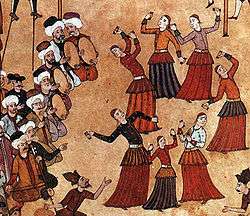Middle Eastern dance
- "Oriental dance" redirects here. For oriental dance in popular culture, see bellydance.

Musicians and a dancing boy (bacha) in Samarkand, ca. 1910

"Köçek troupe at a fair" at Sultan Ahmed's 1720 celebration of his son's circumcision. Miniature from the Surname-i Vehbi, Topkapı Palace, Istanbul.
The traditional dances of the Middle East (also known as oriental dance) span a large variety of folk traditions throughout North Africa, the Middle East, and Central Asia.
"Belly dance" is a Western term applied to raqs sharqi, which is the Arabic for "oriental dance", but strictly a style developed in the interbellum period for professional performance in cabarets and the early Egyptian film industry on the basis of traditional Egyptian dance, by Samia Gamal, Tahiya Karioka, Naima Akef and others.
- Raqs sharqi (Arabic: رقص شرقي; literally "oriental dance") is the style more familiar to Westerners, performed in restaurants, night clubs, cabarets, theatres and other venues around the world. It is more commonly performed by female dancers but is also sometimes danced by men. It is a solo improvisational dance, although students often perform choreographed dances in a group.
- Raqs baladi, (Arabic: رقص بلدي; literally "dance of country", or "folk" dance) is the many different folkloric styles, danced socially by men and women of all ages in some Middle Eastern countries, usually at festive occasions such as weddings.
- Ghawazi, traditional performative dance of the Egyptian Dom people
- Çiftetelli, Turkish folk dance found in the core territories of the former Ottoman Empire
- Persian dance
- Assyrian folk dance (i.e. khigga)
- Turkish dance
See also
| Wikimedia Commons has media related to Dances of the Middle East. |
External links
- www.asiacastaway.com "Video clip of an Arab men's singing group performing a traditional song and dance"
- Sacred World of Middle Eastern Dance
This article is issued from Wikipedia - version of the 7/24/2016. The text is available under the Creative Commons Attribution/Share Alike but additional terms may apply for the media files.